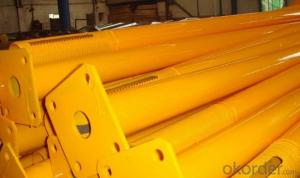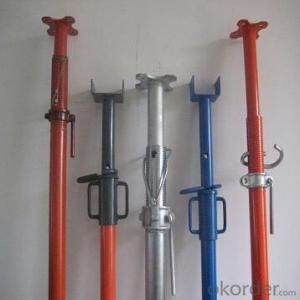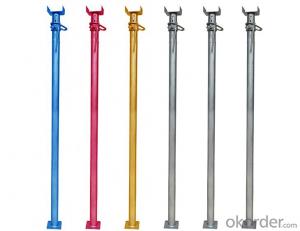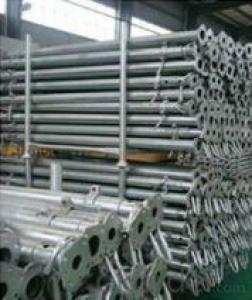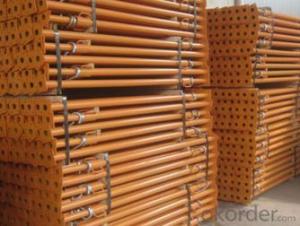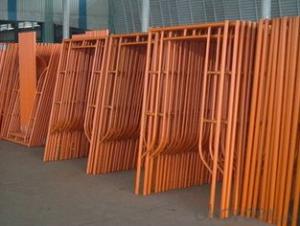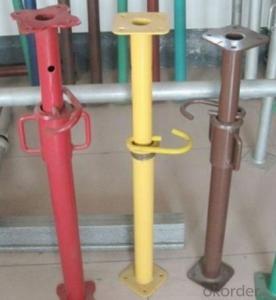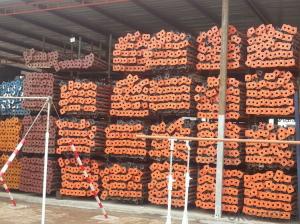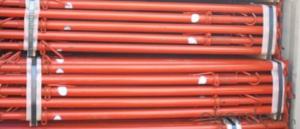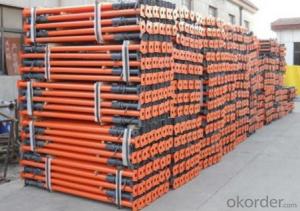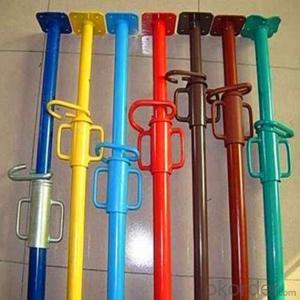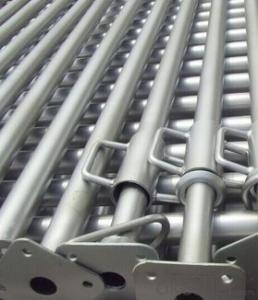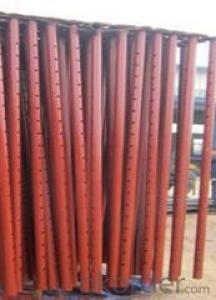High Quality Scaffolding Steel Prop
- Loading Port:
- China Main Port
- Payment Terms:
- TT OR LC
- Min Order Qty:
- -
- Supply Capability:
- -
OKorder Service Pledge
Quality Product, Order Online Tracking, Timely Delivery
OKorder Financial Service
Credit Rating, Credit Services, Credit Purchasing
You Might Also Like
Quick Details
| Type: | |
| Scaffolding Part Type: |
Packaging & Delivery
| Packaging Detail: | CONTAINER |
| Delivery Detail: | 30 DAYS |
Specifications
adjustable steel props
1.material: Q235, Q345
2.surface: painted, galvanized, powdered.
3.diamter:48mm, 56mm, 60mm
Adjustable scaffolding prop
1)Material: Q235;Q345
2)Electro galvanized;HDG;
3)ISO9001;Powder coating
4)U-head component.
we offer premium quality props and Prop sleeves, Prop Nuts
Dimension:
| Item No. | Description | Adjustable Length(mm) | Outside Tube (mm) | Inside tube (mm) | Weight (kgs) | Finishing | |
| Closed | Extended | ||||||
| KH-SP-0800-001 | Spanish Props | 800 | 1400 | 48×1.6×765 | 40×1.8×835 | 4.76 | Painted or Galvanized |
| KH-SP-1600-001 | Spanish Props | 1600 | 3000 | 48×1.6×1600 | 40×1.8×1600 | 7.58 | Painted or Galvanized |
| KH-SP-2000-001 | Spanish Props | 2000 | 3500 | 48×1.6×1716 | 40×1.8×2000 | 8.45 | Painted or Galvanized |
| KH-SP-2200-001 | Spanish Props | 2200 | 4000 | 48×1.6×2000 | 40×1.8×2200 | 9.33 | Painted or Galvanized |
| KH-SP-1600-002 | Italian Props | 1600 | 2900 | 56×1.6×1524 | 48×1.8×1600 | 8.81 | Painted or Galvanized |
| KH-SP-1800-001 | Italian Props | 1800 | 3100 | 56×1.6×1524 | 48×1.8×1800 | 9.21 | Painted or Galvanized |
| KH-SP-2000-002 | Italian Props | 2000 | 3600 | 56×1.6×1750 | 48×1.8×2000 | 10.2 | Painted or Galvanized |
| KH-SP-2200-002 | Italian Props | 2200 | 4000 | 56×1.6×2024 | 48×1.8×2200 | 11.05 | Painted or Galvanized |
| KH-SP-1400-001 | German Props | 1400 | 2700 | 60×2.85×1396 | 48×3.2×1400 | 14.5 | Painted or Galvanized |
| KH-SP-1600-003 | German Props | 1600 | 2700 | 60×2.7×1550 | 48×3.2×1600 | 13.1 | Painted or Galvanized |
| KH-SP-1620-001 | German Props | 1620 | 2640 | 60×2.0×1396 | 48×3.2×1610 | 10.5 | Painted or Galvanized |
| KH-SP-2000-003 | German Props | 2000 | 3500 | 60×2.85×1900 | 48×3.2×2000 | 16.1 | Painted or Galvanized |
| KH-SP-2200-003 | Middel East Props | 2200 | 4000 | 60×3.0×1900 | 48×3.5×2200 | 19.27 | Painted or Galvanized |
| KH-SP-3000-001 | Middel East Props | 3000 | 5500 | 60×3.2×2680 | 48×3.2×2900 | 27.36 | Painted or Galvanized |
- Q: Can steel props be used for temporary support in offshore drilling rig construction?
- Yes, steel props can be used for temporary support in offshore drilling rig construction. Steel props, also known as adjustable steel props or steel acrow props, are commonly used in construction projects to provide temporary support for structures or to hold heavy loads during construction. They are made of high-quality steel and can be easily adjusted to the required height. In offshore drilling rig construction, steel props can be used to support various components or structures during the initial construction phase. For example, they can be used to provide temporary support for the drilling derrick or to hold heavy equipment and machinery in place while they are being installed. The main advantage of using steel props in offshore drilling rig construction is their strength and load-bearing capacity. Steel props are designed to handle heavy loads and can support significant weight without buckling or collapsing. This makes them suitable for the demanding conditions of offshore construction, where stability and safety are crucial. Furthermore, steel props are versatile and can be easily adjusted to different heights, allowing for flexibility in construction. They can be extended or retracted to the desired length, allowing for adjustments as the construction progresses. This adaptability is particularly important in offshore drilling rig construction, where the elevation and position of various components may need to be constantly adjusted. Additionally, steel props are relatively easy to install and dismantle, making them convenient for temporary support in offshore construction. They can be quickly set up and removed as needed, minimizing the time and effort required for construction. In conclusion, steel props can indeed be used for temporary support in offshore drilling rig construction. Their strength, load-bearing capacity, versatility, and ease of installation make them suitable for providing temporary support for various components and structures during the construction process.
- Q: How do steel props compare to hydraulic jacks?
- Steel props and hydraulic jacks are both commonly used for supporting heavy loads in construction projects. However, there are several key differences between the two that make them suitable for different applications. Steel props, also known as steel shoring or acrow props, are adjustable metal poles with a threaded end that can be extended or retracted to the desired height. They are especially useful for providing temporary support to structures during renovations, repairs, or formwork operations. Steel props are known for their robustness, stability, and load-bearing capacity. They are typically made from high-quality steel, making them durable and able to withstand heavy loads. Steel props are easy to install and adjust, allowing for quick and efficient work. On the other hand, hydraulic jacks utilize fluid pressure to lift and support heavy loads. They are commonly used in automotive repair shops, industrial settings, and in situations where precise and controlled lifting is required. Hydraulic jacks consist of a hydraulic cylinder, a pump, and a release valve. By pumping the handle of the jack, hydraulic pressure is built up, causing the cylinder to extend and lift the load. The main advantage of hydraulic jacks is their ability to provide accurate and controlled lifting, making them suitable for delicate operations and where height adjustments are necessary. In terms of comparison, steel props are generally more cost-effective and versatile than hydraulic jacks. Steel props can be easily adjusted to various heights, making them suitable for a wide range of applications. They are also highly durable and can withstand heavy loads without the risk of failure. In contrast, hydraulic jacks are more specialized and typically more expensive. While they offer precise control and are ideal for lifting heavy loads in specific situations, they may not be as versatile or cost-effective as steel props. Overall, the choice between steel props and hydraulic jacks depends on the specific requirements of the project. Steel props are a reliable and affordable option for temporary support and general construction needs, while hydraulic jacks are better suited for precise lifting and controlled operations.
- Q: Can steel props be used in high-rise construction?
- Yes, steel props can be used in high-rise construction. Steel props, also known as adjustable steel props or acrow props, are commonly used to provide temporary support to formwork and scaffolding systems during construction. Their strong and sturdy nature, along with their adjustable height feature, makes them suitable for use in high-rise construction where stability and load-bearing capacity are crucial.
- Q: Can steel props be used to support walls during demolition?
- Yes, steel props can be used to support walls during demolition. Steel props are strong and sturdy, making them suitable for providing temporary support and bracing during the demolition process.
- Q: How do steel props compare to telescopic props in terms of functionality?
- Steel props and telescopic props are both commonly used in construction projects to provide temporary support to structures. While they serve the same purpose, there are some differences in terms of functionality between these two types of props. Steel props, also known as acrow props, are made of strong steel tubes with adjustable lengths. They are typically used to support vertical loads, such as beams or slabs, and provide stability during construction or renovation work. Steel props are known for their robustness and durability, making them suitable for heavy-duty applications. They can withstand high loads and are often used in larger construction projects where greater support is required. On the other hand, telescopic props, also referred to as adjustable props, are designed with a telescopic mechanism that allows for easy height adjustment. These props are commonly used in smaller construction projects or for lighter loads. Telescopic props are often made of aluminum or lightweight steel, making them easier to handle and transport. Their adjustable feature allows for quick and convenient height modifications, reducing the need for additional props of different lengths. In terms of functionality, both steel props and telescopic props have their advantages. Steel props are more suitable for heavy-duty applications where stability and load-bearing capacity are crucial. They are commonly used in larger construction projects, supporting heavy loads and providing long-lasting support. Steel props are also known for their versatility, as they can be easily adjusted to different lengths and are compatible with various accessories. Telescopic props, on the other hand, offer more flexibility and convenience in terms of adjustability. Their telescopic mechanism allows for quick and easy height modifications, reducing the need for multiple props of different lengths. Telescopic props are often preferred in smaller construction projects or scenarios where lighter loads need support. They are lightweight, easy to handle, and can be quickly assembled or disassembled. In conclusion, steel props and telescopic props both have their own unique advantages in terms of functionality. Steel props are known for their robustness and durability, making them suitable for heavy-duty applications, while telescopic props offer flexibility, convenience, and ease of use, making them more suitable for smaller construction projects or lighter loads. The choice between the two will depend on the specific requirements of the construction project and the load-bearing capacity needed.
- Q: How do you determine the required diameter for a steel prop?
- In order to determine the necessary diameter for a steel prop, multiple considerations must be taken into account. First and foremost, the load that the steel prop will need to support is of utmost importance. This includes both the weight of the structure or object being propped up, as well as any additional loads such as wind or equipment loads. The load can be determined by calculating the weight per unit area or utilizing engineering calculations specific to the project at hand. Next, the height or span that the steel prop will need to cover must be considered. The longer the span, the greater the deflection or bending that will occur in the prop. It is crucial that this deflection remains within acceptable limits in order to ensure the structural integrity of the prop and the safety of the supported structure. In addition, the material properties of the steel prop should also be taken into account. Different types of steel possess varying load-bearing capacities, therefore it is essential to select a steel grade that can handle the calculated load. Important properties to consider include the steel prop's yield strength, ultimate tensile strength, and modulus of elasticity. Lastly, the safety factor should be factored in. It is standard practice to apply a safety factor to the calculated load in order to account for unexpected variations or uncertainties in the load. The specific safety factor may differ depending on the project or industry standards. Once all of these factors have been thoroughly evaluated, structural engineers can employ structural analysis and design principles to determine the appropriate diameter for the steel prop. This may involve consulting engineering codes, guidelines, or performing calculations to guarantee the strength and stability of the prop. It is imperative to note that the design and determination of the necessary diameter for a steel prop should be carried out by a qualified structural engineer to ensure compliance with relevant regulations and overall safety.
- Q: Are steel props resistant to electromagnetic interference (EMI)?
- Steel props, in general, exhibit resistance to electromagnetic interference (EMI). Steel, being a highly conductive substance, has the ability to effectively safeguard against electromagnetic fields. This characteristic renders steel an exceptional option for endeavors necessitating EMI protection, including electrical enclosures, industrial equipment, and electromagnetic shielding. Nevertheless, it is crucial to acknowledge that the efficacy of steel props in obstructing EMI is contingent upon diverse factors, encompassing steel thickness, quality, as well as the frequency and intensity of the electromagnetic waves.
- Q: Can steel props be used in the construction of historical monuments?
- Historical monuments can benefit from the utilization of steel props in their construction. These props are commonly employed in renovation or restoration projects to temporarily support structures. Their height can be adjusted as needed, and they are renowned for their strength and stability, making them ideal for reinforcing historical monuments. Preserving the original structure of historical monuments is of utmost importance. By strategically placing steel props, weak or damaged areas can receive the necessary support during repairs or restoration work. This helps distribute weight and enhances the stability of the structure, minimizing potential risks. Moreover, steel props offer versatility in terms of size and adjustability. This allows them to be easily customized to meet the specific requirements of each historical monument. Whether it's reinforcing fragile sections, temporarily supporting walls or ceilings, or aiding delicate architectural features during construction or restoration, steel props are up to the task. Nevertheless, it is crucial to ensure that the use of steel props does not compromise the authenticity and historical integrity of the monument. Proper planning and consultation with historical preservation experts are vital to ensure that the use of steel props respects and preserves the monument's original design and materials. In conclusion, steel props can be effectively employed in the construction of historical monuments to provide temporary support during renovation or restoration work. Their strength, adjustability, and versatility make them an ideal choice for reinforcing weak or damaged areas while preserving the historical integrity of the monument.
- Q: Can steel props be used for temporary support in power plant construction?
- Yes, steel props can be used for temporary support in power plant construction. Steel props are commonly used in construction projects, including power plant construction, to provide temporary support and stability during various stages of the construction process. They offer strong load-bearing capacity and can be easily adjustable to accommodate different heights and angles, making them suitable for temporary support in power plant construction.
- Q: Can steel props be used for temporary support during elevator installation?
- Yes, steel props can be used for temporary support during elevator installation. Steel props are commonly used in construction to provide temporary support and stability to structures. They are adjustable and can be easily installed and removed, making them suitable for temporary applications such as elevator installation.
Send your message to us
High Quality Scaffolding Steel Prop
- Loading Port:
- China Main Port
- Payment Terms:
- TT OR LC
- Min Order Qty:
- -
- Supply Capability:
- -
OKorder Service Pledge
Quality Product, Order Online Tracking, Timely Delivery
OKorder Financial Service
Credit Rating, Credit Services, Credit Purchasing
Similar products
Hot products
Hot Searches
Related keywords
